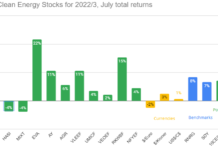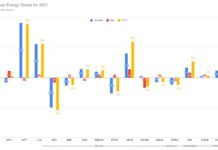A Carbon Conundrum for Christmas
Do we have to choose between happy kids this Christmas, and a happy future for those kids? Practically everything we buy has a negative environmental impact. If green consumption is an oxymoron, so is green giving. Are we left with only greener giving? It often seems that the only way to be truly green is to be like the Grinch (before his heart-enlargement) and not give anyone anything. And skip the tree while you’re at it.
It’s a hard decision, and while there are many Green Shopping Advisories telling us that we can buy and still feel we’re doing something good for the planet, it usually ends up being "less bad" and the green claims are not always as strong as we would hope.
The Gift of a Bright Green Future
The sad truth is, as successful investors know, we nearly always must choose between immediate gratification and long term gain. The whole debate about Global Warming is basically a choice between long term well-being and instant gratification. If you come down on the long term well-being side of the debate, prepare yourself for sighs and disappointed looks from the little ones, and give the gift of stock in a sustainable company that’s working to make the place they live a better place to be.
Which stock to choose? Here are a few criteria I think are important:
- Stability: We should probably stay away from companies aren’t likely to be in business when the kids grow up.
- Greenness: As I noted last week, investing in green companies, like buying presents is often a compromise between greenness and practicality. The profit motive can make a company less brown, but it is unlikely to make it very green (at least until we have stronger environmental regulation.)
- Educational: Most people give stocks to kids hoping to teach them about the market. This will probably work better if the company they own also has a brand they’ll see on a regular basis.
For the stocks I’ve picked below, I rate them on each of these factors on an A-F scale, to help you pick the one or ones you think will be best for your soon-to-be environmentally aware kid.
Top Five Stocks for a Green Christmas
#5. Cree, Inc. (Nasdaq: CREE),
Stability C, Greenness B, Educational C.
You may have never heard of Cree, but they are a world leader in making ultra-bright LED lights, as well as high current power controllers which can significantly increase the performance and efficiency of products that incorporate them. I call LED’s the Compact Fluorescent light bulb of the future (they’re still too expensive for most residential uses,) but they are getting rapidly brighter and cheaper. Although the company is profitable, they have been the subject of takeover rumors, and if they were bought for cash, it might be profitable for your little munchkin, but the lesson in green investing would probably be over.
On the other hand, if you also use energy efficient LED Christmas lights, you might just have the company’s products on hand at the moment of gift-giving (if the LEDs involved happen to be made by another company, who is to know?) Cree will also provide effects lighting for the Beijing Olympics.
#4. The ABB Group (NYSE: ABB)
Stability A, Greenness C, Educational C.
ABB is a bit less fun than Cree, but they’re in great shape in terms of long term profitability, and their expertise in efficient electricity transmission and distribution make them a good long term hold. While they don’t have a lot of consumer awareness among us grownups, I bet your little one will have a lot of fun playing "Spot the ABB logo" in back alleys. I bet you’ll be surprised at how often you see it yourself (see my profile of ABB for details.)
#3. General Electric (NYSE: GE)
Stability A, Greenness D, Educational A.
It’s hard to beat GE for consumer awareness, and the strong marketing push behind their EcoMagination initiative is sure to keep the company in the little one’s mind, even if they missed an entire week of green programming on GE’s NBC TV Network. On the other hand, GE is so gigantic, they get less than 10% of their revenues from EcoMagination products (despite the apparent 90% of their marketing budget devoted to Green.) Nevertheless, I believe that Jeffrey Immelt is serious about green, so green revenues are likely to grow quickly in the future.
Stability B, Greenness A, Educational F.
I know, you’ve never heard of Ormat (unless you’ve been reading the recent spate of articles about Geothermal Power, including the one I wrote.) Ormat is widely recognized as a leader in Geothermal, both in technology, and their ability to run plants well. They are also just about as Pure-Green as any consistently profitable company I know of in the Renewable Energy space. On the downside, you’ll probably never see one of their power plants, although you can always take the kids on a trip to Yellowstone and talk about all the untapped geothermal potential there (long may it remain untapped.)
#1. Sharp (Pink Sheets ADR: SHCAY)
Stability A, Greenness C, Educational B.
While you may not associate Sharp with Greenness, they are the world’s largest manufacturer of photovoltaic panels. The electronics they are more known for seem, from my unscientific sampling, to have a larger proportion of Energy Star qualified products than other manufacturers. I give them the top slot here because photovoltaic solar panels are the first type of Renewable Energy most people think of, and while many of the pure-play PV manufacturers will survive, any particular one could go broke or be bought out in the near future.
Don’t like these? We at AltEnergyStocks.com would love to hear about your picks in the comments… We’ll publish the top reader picks in a couple weeks… still in time for the Christmas Shopping shopping procrastinators.
DISCLOSURE: Tom Konrad and/or his clients have positions in all the stocks mentioned here: CREE, ABB, GE, ORA, SHCAY.
DISCLAIMER: The information and trades provided here are for informational purposes only and are not a solicitation to buy or sell any of these securities. Investing involves substantial risk and you should evaluate your own risk levels before you make any investment. Past results are not an indication of future performance. Please take the time to read the full disclaimer here.








This was a fun article to read. At first glance, I like ABB, I never heard of them before I saw your article on Seeking Alpha. Looks like you run a pretty top notch site here, I’ll be following your commentary from here on in, and adding you to my blog roll. Keep up the good work.
-Jeff M
It’s a great idea to give green stocks for Christmas!
For interested readers http://www.investingforthesoul.com has the latest green investing news.
It also offers a free e-newsletter.
Jeffrey- Thanks for coming over to check it out… it’s nice to see financial professionals are finding something useful in the site.
I just read your article in Seeking Alpha(11/26) on some of your picks for alt-energy for your kids. Very interesting!
I myself are very interested in the long on energy stocks for several reasons. Do you know off hand any funds out there (MMF)
that may encompass any , or all, of the stocks you mentioned in one portfolio?
I’m also looking for a long term fund that has holdings in JCI, FPL, WMI, ADM,
Any recommendations?
Happy Holidays…
Mr. Stahl
Franz-
Thanks for your comment… and for moving it over from email so that others can read it, too. (Although, it looks like I sent you to the wrong entry, and you intended this to be a comment on my Blue Chip Alternative Energy Portfolio.)
Only the greenest of these stocks are in most of the sector mutual funds and ETFs. The others are usually excluded since more than half of their revenues/profits are from outside alternative energy.
For the individual investor, you may actually be better off just buying equal dollar amounts of each of the stocks as a replacement for a large-cap mutual fund in your poertfolio. The typical mutual fund has an expense ratio of 1%, which means if you have $20,000 invested, you pay (without seeing it) $200/year to be invested. A typical discount broker charges $10-$15 a trade, so you could buy 15-20 stocks at that price and break even in the first year, and pay little or nothing in future years.
I detail this strategy at the end of this article: Introduction to Investing in Renewable
Energy.
A typical way to get exposure to Alternative
energy would be to buy one of the Mutual Funds or ETFs with 5-20% of your
portfolio, with the balance of your portfolio in stock and bond index
funds. I see the Blue
Chip Alternative Energy portfolio as a less expensive alternative for
someone who wants exposure to the sector, but does not want to pay the high fees
of the mutual funds or ETFs. To compensate for the fact that these
companies only get a fraction of their revenues from Alternative Energy, a
person would buy more of these Blue Chip Alte E stocks than they would of an
alternative enrgy mutual fund, and reduce their general market holdings by a
similar amount.
For example, if you wanted $10,000 in Alternative Energy, $60,000 in other
stocks, and $30,000 bonds, you could chose to buy $2,000 of each of the 22
companies in the Blue chip Stock list for $44,000, and put $16,000 into a small
cap index fund (to balance the fact that these are all large cap stocks), and
the same $30,000 into a bond mutual fund. People with larger portfolios
interested in buying individual bonds could also look for bonds of the companies
listed, thus greening their bond portfolios as well (although they should
probably buy less of the stock of a company in which they buy bonds.)
I feel a bit uneasy about the recommendation of both GE and Sharp on the basis of their alternative energy or cleantech businesses.
First of all they both have so many other businesses that dwarf their alternative energy businesses. Are their cleantech businesses (very good ones) are sufficiently large to significantly affect their earnings and hence stock prices? Certainly not in the case of GE and probably not in Sharp’s case either.
Maybe they will someday, but not now.
Moreover, GE’s Immelt has publicly stated that GE’s ‘Ecoinnovation’ campaign is a purely a PR strategy and that GE certainly isn’t a “green” company. This is not to single out GE (there are many worse offenders such as ADM, BP, and Waste Management), but only to suggest that GE isn’t a good recommendation as an alternative energy or ‘green’ investment.
In addition, GE has been a laggard in environmental stewardship (both in products and operation) – though it has improved markedly since the days of CEO Jack ‘Pillage & Plunder’ Welch.
Raphael,
I agree that GE and Sharp are very poor examples of “green” companies. You will note that I rated their “Greenness” D, and C, respectively. The “greenness” of these companies (especially GE) lies in their future, not their past. Current purchasers of GE are not voting Jack Welch’s management strategy (since he retired a couple years ago), they are voting for Jeffrey Immelt’s strategy, which has been to focus the company more on green innovation (I disagree that Ecomagination is a purely PR campaign, but it is possible that I’ve been fooled.) I would be very interested to see the quote you refer to.
While more than 90% of GE’s revenues cannot currently be considered green, a large part of their future revenue growth will come from these sectors. When you buy a stock, you are not buying its past, but it’s future.
Nevertheless, even the future of these companies is not pure green. If that is your intent, one of my other picks, most likely Ormat would be best. This is why I chose to give readers 3 ratings (Stability, Greenness, and Educational), which would allow them to choose the stock that was best suited to their needs.